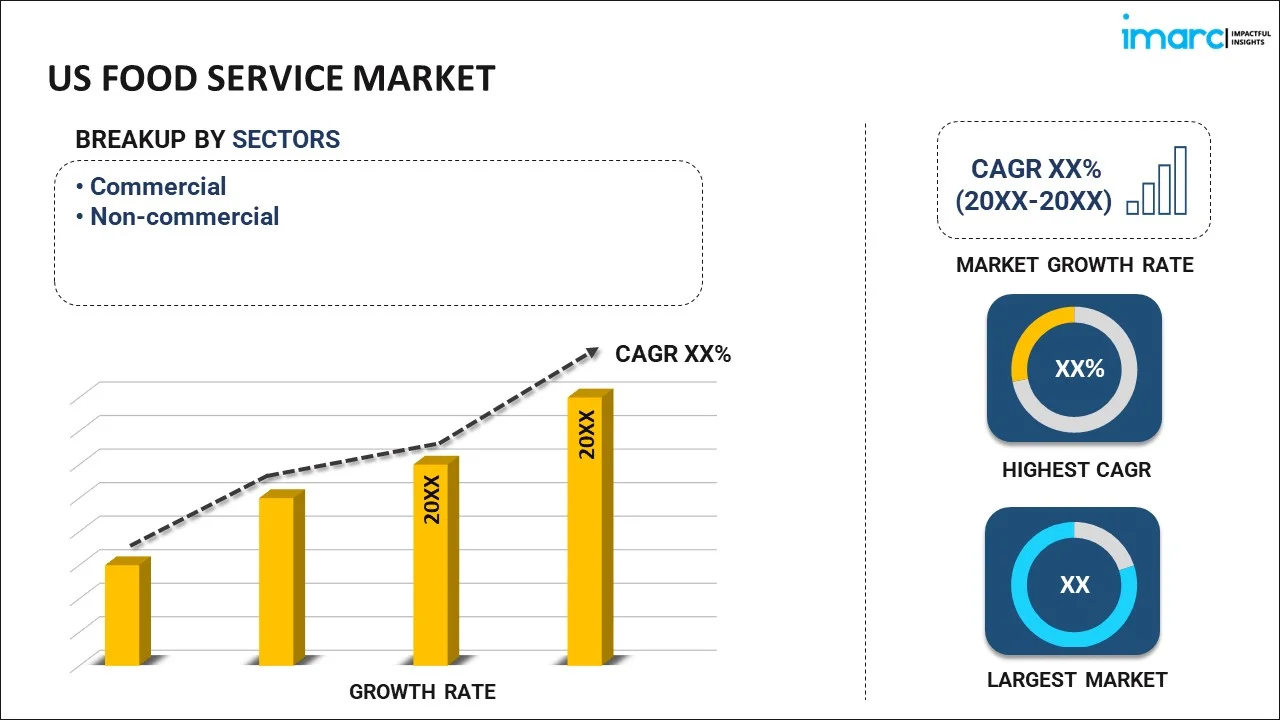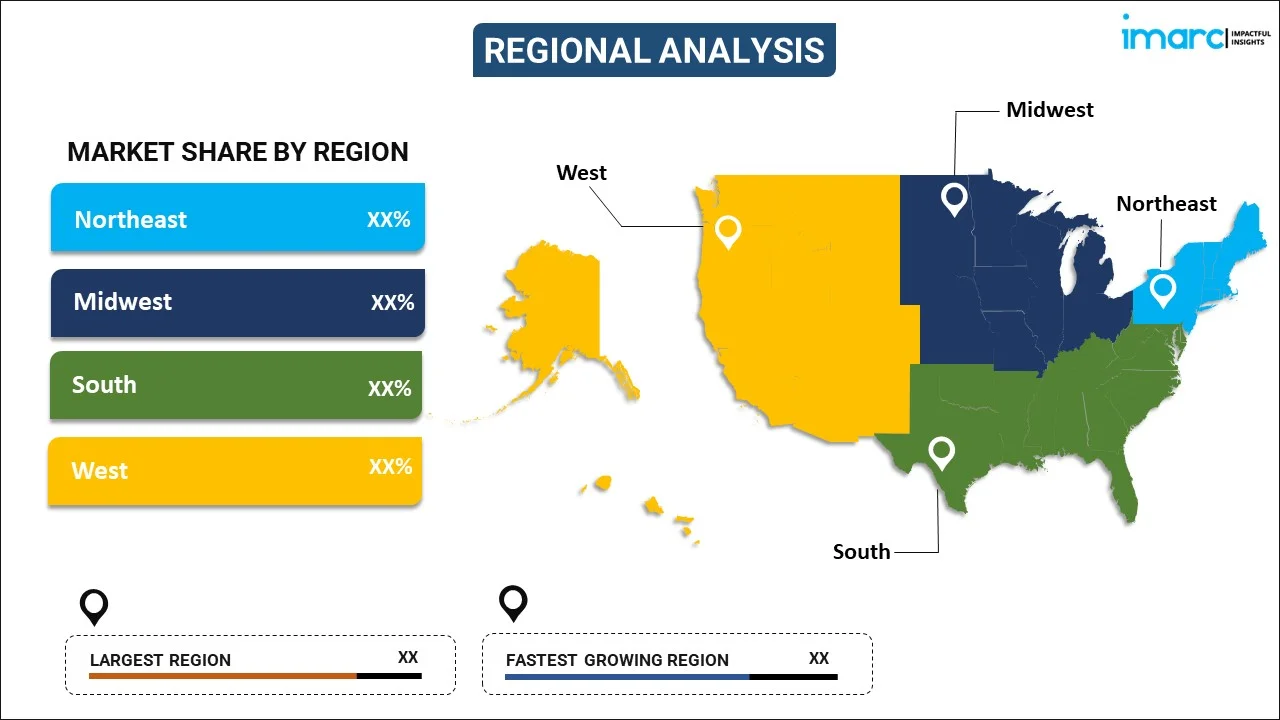
US Food Service Market Report by Sector (Commercial, Non-commercial), System (Conventional Foodservice System, Centralized Foodservice System, Ready Prepared Foodservice System, Assembly-Serve Foodservice System), Type of Restaurant (Fast Food Restaurants, Full-Service Restaurants, Limited Service Restaurants, Special Food Services Restaurants), and Region 2025-2033
Market Overview:
US food service market size reached USD 1,515.5 Billion in 2024. Looking forward, IMARC Group expects the market to reach USD 2,613.0 Billion by 2033, exhibiting a growth rate (CAGR) of 6.24% during 2025-2033. The increasing demand for automation in the kitchen, digital menus, and other innovations that can enhance efficiency and customer experience, is driving the market.
|
Report Attribute
|
Key Statistics
|
|---|---|
|
Base Year
|
2024
|
|
Forecast Years
|
2025-2033
|
|
Historical Years
|
2019-2024
|
|
Market Size in 2024
|
USD 1,515.5 Billion |
|
Market Forecast in 2033
|
USD 2,613.0 Billion |
| Market Growth Rate 2025-2033 | 6.24% |
US Food Service Market Analysis:
- Key Drivers: US food service market growth is led mainly by rising urbanization and population changes, technological innovation such as automation and online ordering platforms, enhanced disposable incomes that translate into increased eating out spending, and increasing consumer appetite for convenience dining options and ready meals across different service categories.
- Key Market Trends: The market is fueled by the adoption of sustainable and environmentally friendly practices, incorporation of artificial intelligence for operational optimization, expansion of delivery and takeout services, and rising demand for plant-based and health-focused menu options as a response to changing consumer trends.
- Challenges: The US food service market analysis indicates challenges such as climbing operating expenses and labor shortages, growing competition from conventional and emerging food service operators, regulatory compliance for food hygiene and safety standards, and supply chain disruptions that impact ingredient supply and price volatility.
- Opportunities: The major opportunities include expansion into underserved geographic areas, innovation in service models with technology solutions, joint ventures with food delivery platforms for better market penetration, and introduction of specialty diet offerings for certain consumer groups and preferences.
Food service refers to the process of preparing, presenting, and delivering food to consumers. It encompasses a wide range of activities within the food industry, including restaurants, cafes, catering services, and institutional food providers. The primary goal of food service is to offer convenient and satisfying meals to customers, whether in a dining establishment, through take-out or delivery, or in large-scale settings such as schools or hospitals. Successful food service operations involve careful planning, efficient kitchen management, and a focus on delivering high-quality, safe, and flavorful dishes. Customer satisfaction is a key factor, and excellent service, appealing presentation, and adherence to hygiene standards contribute to a positive dining experience. The food service industry plays a vital role in meeting the diverse culinary preferences and nutritional needs of the public, reflecting cultural trends, and contributing to the overall hospitality and enjoyment of individuals and communities.
US Food Service Market Trends:
Technology Integration and Automation Trend
The US food service industry demand is experiencing unprecedented technological change as restaurants increasingly embrace automation systems, digital ordering systems, and artificial intelligence technologies. Restaurants are installing robotic kitchen helpers, automatic ordering kiosks, and AI-based inventory control systems to maximize operating efficiency and minimize labor costs. Cloud point-of-sale technology provides real-time analytics and customer data management, while mobile apps allow for smooth ordering convenience. Digital menu boards and QR code ordering are now common features, especially driven by post-pandemic shopper behavior. Smart kitchen appliances with IoT connectivity enable accurate cooking control and proactive maintenance. Not only do these technology features streamline operations, but also they enhance customer satisfaction through improved speed of service delivery as well as tailored experiences. The use of blockchain technology for supply chain visibility and contactless payment mechanisms also shows the focus of the industry on being innovative and meeting consumer safety demands.
Sustainability and Eco-Conscious Practices Trend
Sustainability has become a hallmark of the contemporary US Food service market growth, with businesses increasingly embracing green practices in all aspects of their operations. Restaurants are giving emphasis to locally sourced products to minimize carbon footprints, using extensive waste minimization schemes, and switching to biodegradable packing materials. Plant-based food items have increased dramatically, responding to increased consumer interest in eco-friendly eating options. Energy-efficient installation of equipment, water-saving systems, and composting initiatives are now mainstream sustainability practices. Numerous establishments are obtaining green certifications and openly declaring their environmental efforts to customers. Zero-waste kitchens and farm-to-table alliances are increasing, highlighting the sector's focus on environmentally friendly food systems. Also seen are sustainable seafood procurement and organic ingredient sourcing, which indicate the industry's reaction to consumer concern over environmental footprint. These habits not only solve environmental issues but also appeal to green consumers, generating competitive benefits and brand loyalty in a more congested market.
Health and Wellness Focus Trend
The wellness and health trend is actually transforming the market landscape as consumers become more focused on healthy, transparent, and functional foods. Restaurants are revamping their menus to provide gluten-free, keto, low-sodium, and nutrient-dense foods based on variety of dietary needs and health-aware choices. Ingredient transparency and nutritional information have become the necessity, with places offering comprehensive caloric content and allergen data. Functional foods containing superfoods, probiotics, and immune-boosting ingredients are increasingly popular across service segments. Plant-based food has moved beyond the usual vegetarian fare to creative protein substitutes and nutrient-dense preparations. Portion control programs and healthy meal options with customization enable consumers to take charge of their diet. Mental wellbeing awareness has also impacted menu construction, with comfort food being redefined by healthier cooking methods and ingredients. The inclusion of nutritionist guidance and wellness programs within business food service operations indicates the industry's holistic strategy for addressing consumer health goals and lifestyle choices.
US Food Service Market Segmentation:
IMARC Group provides an analysis of the key trends in each segment of the market, along with forecasts at the country level for 2025-2033. Our report has categorized the market based on sector, system, and type of restaurant.
Sector Insights:

To get more information on this market, Request Sample
- Commercial
- Non-commercial
The report has provided a detailed breakup and analysis of the market based on the sector. This includes commercial and non-commercial.
System Insights:
- Conventional Foodservice System
- Centralized Foodservice System
- Ready Prepared Foodservice System
- Assembly-Serve Foodservice System
A detailed breakup and analysis of the market based on the system have also been provided in the report. This includes conventional foodservice system, centralized foodservice system, ready prepared foodservice system, and assembly-serve foodservice system.
Type of Restaurant Insights:
- Fast Food Restaurants
- Full-Service Restaurants
- Limited Service Restaurants
- Special Food Services Restaurants
The report has provided a detailed breakup and analysis of the market based on the type of restaurant. This includes fast food restaurants, full-service restaurants, limited service restaurants, and special food services restaurants.
Regional Insights:

- Northeast
- Midwest
- South
- West
The report has also provided a comprehensive analysis of all the major regional markets, which include Northeast, Midwest, South, and West.
Competitive Landscape:
The market research report has also provided a comprehensive analysis of the competitive landscape in the market. Competitive analysis such as market structure, key player positioning, top winning strategies, competitive dashboard, and company evaluation quadrant has been covered in the report. Also, detailed profiles of all major companies have been provided.
Recent News and Development:
- In March 2025, Ladle™ officially became one platform serving the foodservice, restaurant, and grocery sectors, bringing ComplianceMate™, MeazureUp™, and Storewise™ together as a single brand. Supporting more than 18,000 sites globally, Ladle simplifies operations, enforces compliance, and increases profitability through holistic solutions for food safety, workflow management, and data-driven decision-making. Headed by CEO Todd Gebski, the platform's goal is to make operations easier, facilitate collaboration, and provide more efficiency and value to operators.
- In February 2025, Apple is adding a food section to its News+ service, Apple News+ Food, which debuts with iOS 18.4 and iPadOS 18.4 in April. The section will include tens of thousands of recipes, restaurant reviews, healthy eating advice, and kitchen basics from sources such as Allrecipes, Bon Appétit, Food & Wine, Good Food, and Serious Eats. Certain recipes and some content will also be available to non-subscribers. Apple is looking to get into the burgeoning online cooking space.
US Food Service Market Report Coverage:
| Report Features | Details |
|---|---|
| Base Year of the Analysis | 2024 |
| Historical Period | 2019-2024 |
| Forecast Period | 2025-2033 |
| Units | Billion USD |
| Scope of the Report | Exploration of Historical Trends and Market Outlook, Industry Catalysts and Challenges, Segment-Wise Historical and Future Market Assessment:
|
| Sectors Covered | Commercial, Non-commercial |
| Systems Covered | Conventional Foodservice System, Centralized Foodservice System, Ready Prepared Foodservice System, Assembly-Serve Foodservice System |
| Types of Restaurant Covered | Fast Food Restaurants, Full-Service Restaurants, Limited Service Restaurants, Special Food Services Restaurants |
| Regions Covered | Northeast, Midwest, South, West |
| Customization Scope | 10% Free Customization |
| Post-Sale Analyst Support | 10-12 Weeks |
| Delivery Format | PDF and Excel through Email (We can also provide the editable version of the report in PPT/Word format on special request) |
Key Benefits for Stakeholders:
- IMARC’s industry report offers a comprehensive quantitative analysis of various market segments, historical and current market trends, market forecasts, and dynamics of the US food service market from 2019-2033.
- The research report provides the latest information on the market drivers, challenges, and opportunities in the US food service market.
- Porter's five forces analysis assist stakeholders in assessing the impact of new entrants, competitive rivalry, supplier power, buyer power, and the threat of substitution. It helps stakeholders to analyze the level of competition within the US food service industry and its attractiveness.
- Competitive landscape allows stakeholders to understand their competitive environment and provides an insight into the current positions of key players in the market.
Key Questions Answered in This Report
The food service market in the US was valued at USD 1,515.5 Billion in 2024.
The US food service market is projected to exhibit a CAGR of 6.24% during 2025-2033, reaching a value of USD 2,613.0 Billion by 2033.
The market is driven by increasing demand for automation in kitchen operations and digital menu innovations, growing urbanization and population growth leading to higher demand for convenient dining, technological advancements in online food delivery platforms, and evolving consumer preferences towards healthier and sustainable food options.
Need more help?
- Speak to our experienced analysts for insights on the current market scenarios.
- Include additional segments and countries to customize the report as per your requirement.
- Gain an unparalleled competitive advantage in your domain by understanding how to utilize the report and positively impacting your operations and revenue.
- For further assistance, please connect with our analysts.
 Request Customization
Request Customization
 Speak to an Analyst
Speak to an Analyst
 Request Brochure
Request Brochure
 Inquire Before Buying
Inquire Before Buying




.webp)




.webp)












